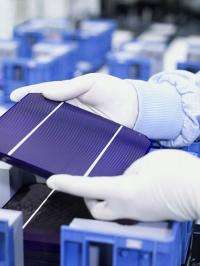February 27, 2012 weblog
Paper highlights need for correctly measuring solar cell efficiency

(PhysOrg.com) -- As the pace of solar cell research continues to accelerate, the question for every new design is “what’s its efficiency?” Since measuring how efficiently a solar cell converts sunlight into electricity involves several factors, making a correct measurement can be challenging. Henry Snaith, a physicist at the University of Oxford who designs solar cells, estimates that compounding small mistakes in measuring efficiency can result in overestimations of up to five times that of the actual value.
To address this problem, Snaith has written a guide for researchers on correctly measuring solar cell efficiency for different types of solar cells. As he explains in the paper published in Energy & Environmental Science, a uniform method for measuring efficiency is essential for enabling valid comparisons.
“There's an ongoing stream of papers in which it's not entirely clear exactly how the measurements have been made,” Snaith said in an article in Chemistry World. “If, for example, someone claims their hybrid solar cell has an efficiency of 4% when it's really more like 1%, that makes it problematic for someone else to write an exciting paper when they've genuinely improved something to 1.5%.”
One of the most common potential sources of error that Snaith identifies involves how to mask the cells, which determines the size of the test area. Other problems can occur due to light source calibration and how the cell is positioned during testing. Snaith outlines standards for all these steps, and explains how small deviations can inadvertently cause errors.
Snaith emphasized that the purpose of the guide is not to find fault, but to address the challenges involved in the rapidly growing field of solar cell technology that is attracting researchers from diverse backgrounds. He hopes that the guide will encourage new ideas and increase the rate of new breakthroughs.
“The research field of photovoltaics is booming due to the recognized imperative to realize long-term solutions to clean and inexpensive power generation,” he writes. “…If these standard protocols are adhered to across the field, then a much better comparison between literature values of efficiency can be made and more rapid and well-directed technological advancements will occur.”
More information: Henry Snaith. “How should you measure your excitonic solar cells?” Energy Environ. Sci., 2012, Accepted Manuscript. DOI: 10.1039/C2EE03429H
via: Chemistry World
© 2011 PhysOrg.com




















